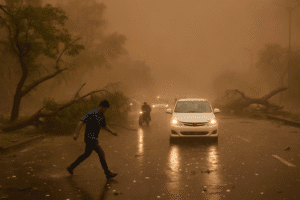Delhi-NCR Storm Chaos: 7 Shocking Impacts of Violent Weather You Can’t Ignore
A violent dust storm struck Delhi-NCR on May 22, 2025, plunging the region into chaos with wind speeds of 79 km/h, hail, and heavy rain that rapidly dropped temperatures from 37°C to 23°C. The storm caused widespread disruption, flooding streets, toppling trees, damaging power lines, and halting metro and flight operations. Residents described apocalyptic scenes, with walls of dust and marble-sized hailstones battering homes and vehicles. Experts from the IMD traced the storm to a cyclonic circulation over Haryana, intensified by a trough pulling in moisture from both coasts.
Scientists warn such intense pre-monsoon events are becoming more frequent due to climate change. Despite no fatalities, the storm exposed Delhi’s fragile infrastructure and triggered health concerns from dust inhalation. Authorities faced backlash over delayed warnings, prompting renewed calls for real-time alerts, stronger infrastructure, and climate-resilient urban planning. As cleanup begins, Delhi’s resilient spirit shines through, but the storm serves as a sobering reminder of the urgent need to adapt to extreme weather events.

Delhi-NCR Storm Chaos: 7 Shocking Impacts of Violent Weather You Can’t Ignore
Residents of Delhi-NCR faced nature’s fury on Wednesday evening as a ferocious dust storm, accompanied by hail and torrential rain, wreaked havoc across the region. The sudden tempest, which saw wind speeds surge to 79 km/h, transformed skies into a murky brown haze, reducing visibility to near-zero and sending temperatures plunging from 37°C to 23°C within hours.
The Storm’s Wrath: A City Brought to Its Knees
Videos circulating on social media captured the apocalyptic scenes: towering dust clouds engulfing neighborhoods, trees thrashing violently, and streets flooding within minutes. In East Delhi’s Yamuna Vihar and Bhajanpura, residents described “walls of dust” blotting out the sun, while hailstones the size of marbles pummeled cars and rooftops in Noida and Ghaziabad. Commuters scrambled for shelter as debris flew across roads, and emergency services raced to clear fallen branches and power lines.
Why Did This Happen? The Science Behind the Storm
According to the India Meteorological Department (IMD), the chaos stemmed from a cyclonic circulation over Haryana, amplified by an east-west trough stretching from Punjab to Bangladesh. This system pulled moisture from both the Arabian Sea and Bay of Bengal, creating unstable atmospheric conditions. “Such abrupt weather shifts are typical during pre-monsoon months, but the intensity here is alarming,” explained Dr. Rajesh Kumar, a climatologist at Delhi University. “Rising surface temperatures and erratic wind patterns—both linked to climate change—are making these events more volatile.”
Transport Turmoil: Flights, Metro Lines Disrupted
The storm’s impact rippled across transportation networks:
- Delhi Metro: Services on the Red and Yellow lines faced delays after debris damaged overhead equipment near Jahangirpuri and Nizamuddin. While Pink Line operations resumed quickly, Greater Noida’s Aqua Line remained suspended for hours.
- Indira Gandhi Airport: Over 30 flights were diverted or delayed. An IndiGo flight from Delhi to Srinagar narrowly averted disaster after severe turbulence damaged its nose cone during landing.
- Roadways: Waterlogging and uprooted trees caused gridlocks on key routes like the Delhi-Meerut Expressway.
Human Toll: Resilience Amid Crisis
While no fatalities were reported, the storm exposed vulnerabilities in urban infrastructure. “My auto-rickshaw shook so hard, I thought it would flip over,” recounted Priya Sharma, a schoolteacher stranded in Connaught Place. Meanwhile, hospitals noted a spike in respiratory complaints due to dust inhalation.
Lessons and Preparedness
Authorities faced criticism for delayed advisories, though the IMD had issued a thunderstorm alert earlier that day. Experts urge proactive measures:
- Infrastructure Upgrades: Reinforcing overhead metro lines and drainage systems.
- Public Awareness: Real-time alerts via SMS and apps for commuters.
- Green Initiatives: Expanding urban tree cover to combat dust storms.
Looking Ahead
As Delhi cleans up, questions linger about adapting to climate extremes. “This isn’t just a weather event—it’s a wake-up call,” asserts environmentalist Anjali Patel. “Cities must prioritize resilience, or face escalating crises.”
For now, Delhi’s spirit remains unbroken. As shopkeeper Ramesh Gupta in Lajpat Nagar quipped while sweeping debris, “Nature tested us, but we’ll rebuild—until the next storm.”
You must be logged in to post a comment.